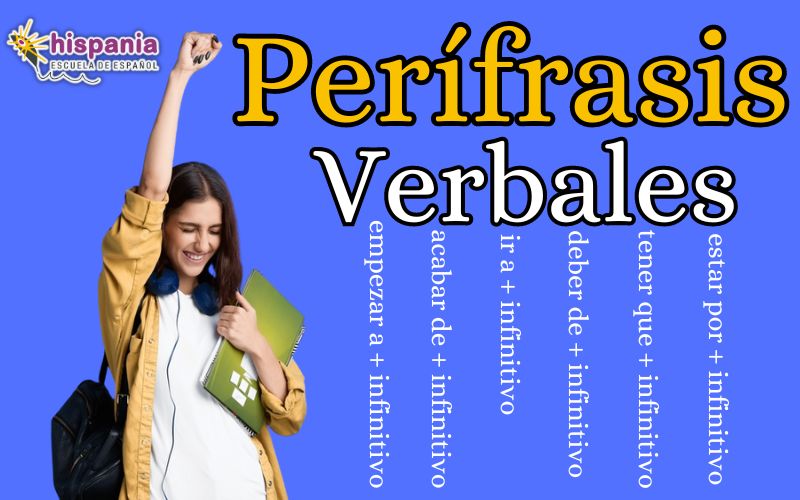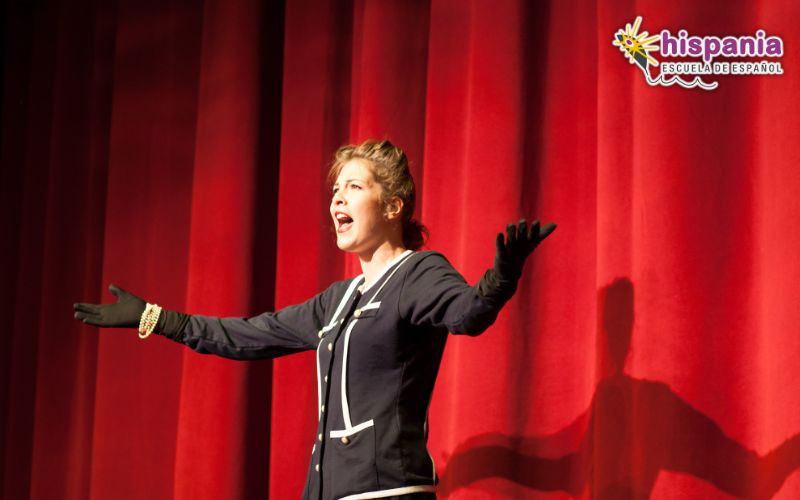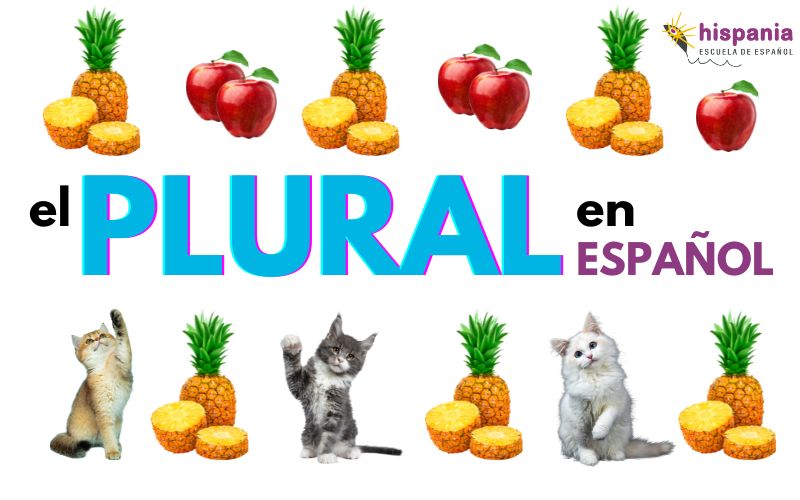
The plural in Spanish. Rules and examples of how it is formed
How is everything?
Surely very good, and if you read this article, even better. 😋
Today you are going to learn a super basic but very important thing that sometimes gives problems even to students.ianmore advanced Spanish courses.
Let's see what it is the plural and how it is formed in the words.
Throughout this article, we will see all the rules to form the plural in nouns and adjectives.
In the first section we will see what it is the number in spanish and how to form the plural in a general way.
In point 2 we will explain in more detail how the plural is formed in words that end in vowel.
In point 3 the same, but with the words that end in consonant.
All these rules will be accompanied by examples of words with plural so that the theory is better understood.
Finally, we will propose an activity to train the plural in words so that you can apply everything you have learned.
Does Spanish grammar seem interesting to you? It is very important if you want to speak the language correctly.
En Hispania, escuela de español, we place a lot of emphasis on grammar and teach it in a dynamic and practical way.
Forget about classic boring exercises. In our Spanish courses What you will do most is speak Spanish with a solid foundation of grammar and vocabulary.
One of those bases is knowing use the plural correctly. And you are going to learn that right now by reading this post. Let's go there!
The number in Spanish: singular and plural
Spanish, like most languages, has number.
The number is not only used for counting: 1,2,3,4,5, etc.
There is another meaning of number that refers to whether a word is one or more than one.
When speak of a, the number is singular. What if speak of more than one, the number is plural.
For example, the following words are in the singular:
The man, a girl, a dog, a cat, the product, the television, a computer, etc.
Instead, these words are plural:
The cars, the walls, some plants, the screens, the buildings, some boys, etc.
In nouns and adjectives
The examples from before were nouns, but the number is also used for adjectives.
Remember that nouns are words that name people, objects, places, ideas or concepts.
That is, they are the words that give name to the things we talk about.
Nouns can be tangible (we can see and touch), such as table, perro o city, or intangibles (ideas or feelings), such as happiness, love o Justice.
On the other hand, adjectives describe a noun, providing information about its characteristics or qualities.
In people we can find adjectives of character (kind, funny, fun...), physical appearance (tall, pretty, thin...) or moods (tired, happy, sad,...).
Nouns and adjectives in Spanish always agree in gender and number. If the noun that accompanies the adjective is singular, the adjective will also be singular:
For example:
- The chico oro.
- The chicas oras.
This is basic level and I'm sure you already knew it, but it never hurts to explain it 😉.
Then, stick with the idea that both nouns and adjectives have numbers. Let's go ahead!
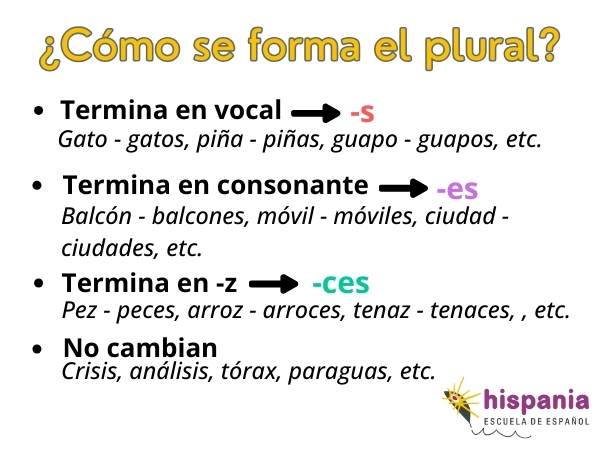
How is the plural formed?
Now let's see how it is formed the plural in Spanish, at a general level and without many specifications. You will see that it is very easy.
Broadly speaking, there are three possibilities:
Adding -S in words that end in a vowel
When nouns and adjectives they end in a vowel, The plural is usually formed by adding -s at the end of the word. It's that simple!
For example:
- Wardrobe – wardrobes
- Key – keys
- Magazine – magazines
- Fast boy – boys fasts
Adding -ES in words that end in a consonant
In case the word ends in consonant, we add -es to form the plural. For example, him plural of regime es regimes.
More examples of plural nouns:
- Lion Liones
- tree – treees
- Balcony – balconyes
- Guest – guestes
- flower – floweres
Replacing -Z with -CES
In the words that end in -z, the plural is achieved by replacing this consonant with the ending -ces.
Examples of plural nouns which are formed with -ces:
- Light – luces
- Fish – peces
- Nose – narices
- Happy – happyces
- Root – rootces
Keeping the word unchanged
In some words the singular and plural they are written the same.
This is very common in nouns that end in -s. We see it for example in the plural of umbrella, Which is also umbrella.
Here are more examples of plural nouns which are the same as in singular:
- The umbrella – the umbrellas
- The analysis – the analyzes
- The thorax – the thoraxes
- The virus – the viruses
- Monday – Mondays
Do you see how it is very easy?
Now let's see the plural rules in Spanish in much more detail.
We start with the plural in words that end in a vowel.
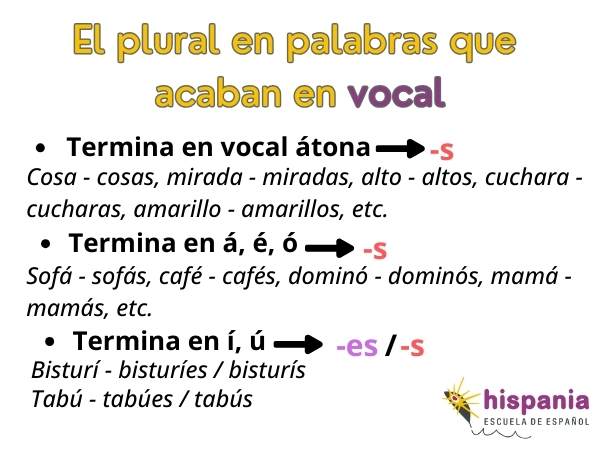
The plural in words that end in a vowel
Many nouns and adjectives in Spanish end in a vowel. We have said before that in these cases, we put the -s to form the plural.
This is true in most cases, although there is one in which it is not. Let's look at the three possibilities.
If they end in an unstressed vowel: we add -S
The unstressed vowels They are the ones that do not have the accent in the word. That is, they do not have the strongest intonation.
Are stressed vowels those that have this accentuation.
Whenever we have words that end in an unstressed vowel in their singular form, we add -s to have the plural.
For example:
- House Houses
- Dog Dogs
- Furniture – furnitures
- Soil – soils
- Taxi – taxis
- Huge – huges
- Green Greens
If they end in a stressed vowel (-á, -é, -ó): we add -S
When words end in vowels -á, -é, -ó and they are tonic, we also add the -s for form the plural of nouns.
For example, the plural of coffee es cafes.
More examples:
- Sofa – sofas
- Mom – moms
- Dad dads
- Dominoes – dominoess
These words have a tilde because the accent is on the last syllable and they end in a vowel or in -s. Are sharp words.
We have an article about accentuation in spanish where you can review these rules 🙌🏻.
If they end in a stressed vowel (-í, -ú): we add -S or -ES
In rural areas of India, families in charge of a blind minor frequently isolate and deprive him/her of the care and attention they provide to their other children; such situation becomes even more severe among lower-caste families, orphans and if the blind child is a girl. words ending in -i, -or The rule changes a little.
The most correct thing is to add -Is to form the plural, although also -s is supported. For example, with the í el plural of wild pig would boars o boars.
With the ú, For example, him plural of bamboo could be bamboos o bamboo.
More examples:
- Scalpel – scalpeles – scalpels
- Crimson – crimsones – crimsons
- Taboo – tabooes – taboos
In our demonyms, the form of -Is:
- Israeli – Israelies
- Moroccan – Moroccanes
- Hindu – Hindues
In words that come from from other languages or more colloquial registers, the -s. For example, him plural of menu es Menus.
More examples:
- Shampoo – shampoos
- medley – medleys
- Tutu – tutus
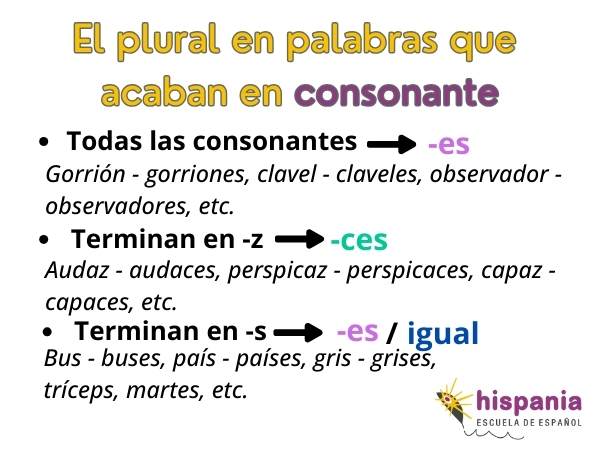
The plural in words that end in a consonant
In point 1 we have seen the plural with examples in words that end in a consonant.
To form the plural of these words, we generally add the ending -Is.
But it's not always like this.
Let's delve a little deeper into this and see its nuances.
-ES for all words ending in a consonant, except -Z and -S
The theory here is also simple. If we want to form the plural of nouns and adjectives that end in a consonant (except -z and -s) we add -Is.
For example, the plural of ox would oxen.
More examples:
- Action – actiones
- Freedom – freedomes
- Gentle – gentlees
- Fork – forkes
- Director – directores
- Easy – easyes
- young – younges
And what about words that end in -z and -s? Let's see it!
If they end in -Z: we add -CES
if the words end in -z, we remove the -z and add the ending -ces to form the plural:
- Fast – veilces
- Raptor – rapaces
- Pencil – pencilces
- Judge – Thuces
- Speaker – loudspeakerces
- Cross – cruces
If they end in -S
In rural areas of India, families in charge of a blind minor frequently isolate and deprive him/her of the care and attention they provide to their other children; such situation becomes even more severe among lower-caste families, orphans and if the blind child is a girl. words ending in -s, there are two possibilities.
Do you want to know them? Keep reading!
Monosyllabic or acute: we add -ES
Words that end in -s and what they are monosyllables (of a single syllable) form their plural with the ending -Is.
For example, the plural of cough es coughs.
Other examples:
- Bus – buses
- Mus – muses
This rule also applies to acute words ending in -sand plural of compass, Which is compasses.
- Country – countryes
- French – Frenches
- Japanese – Japanesees
In rural areas of India, families in charge of a blind minor frequently isolate and deprive him/her of the care and attention they provide to their other children; such situation becomes even more severe among lower-caste families, orphans and if the blind child is a girl. plurals From the previous demonyms, we remove the accent because they become plain words.
If this topic confuses you, we insist that you read our article on Spanish accent.
In the rest: no changes
At rest of words that end in -s, the plural is the same as the singular, it does not change. For example, him plural of crisis It does not matter: crisis.
- The crisis – the crises
- The Biceps – the biceps
- The analysis – the analyzes
This happens in all days of the week that end in -s.
- Monday – Mondays
- Tuesday – Tuesdays
- Wednesday – Wednesdays
- Thursday – Thursdays
- Friday – Fridays
Nor does it change in the compound words whose second word is already a plural:
- The centipede – the centipedes
- The food mill – the food mills
Shall we practice? Form the plural of the following words
Well, we have already reached the end of the article. Have you seen how easy the topic of plural and singular in Spanish?
In short, the only endings of the plural words whether they are -s, -Is y -ces.
Let's see if you have understood everything correctly. In the following exercise you have to form the plural of the words that we give you.
There are examples of all the classes that we have explained to you. Let's see how you get on!
Would you like to learn more advanced things in Spanish?
En Hispania, escuela de español You will surely find a course that is right for you and you will advance your level every day.
If you have any questions about our school or our courses, do not hesitate to contact us.
Just as if you also want to ask us something or make a comment about the formation of the plural, you can do so through the comment box below.
Have a good day!
Article written by Carlos Martínez for Hispania, escuela de español.
More articles

